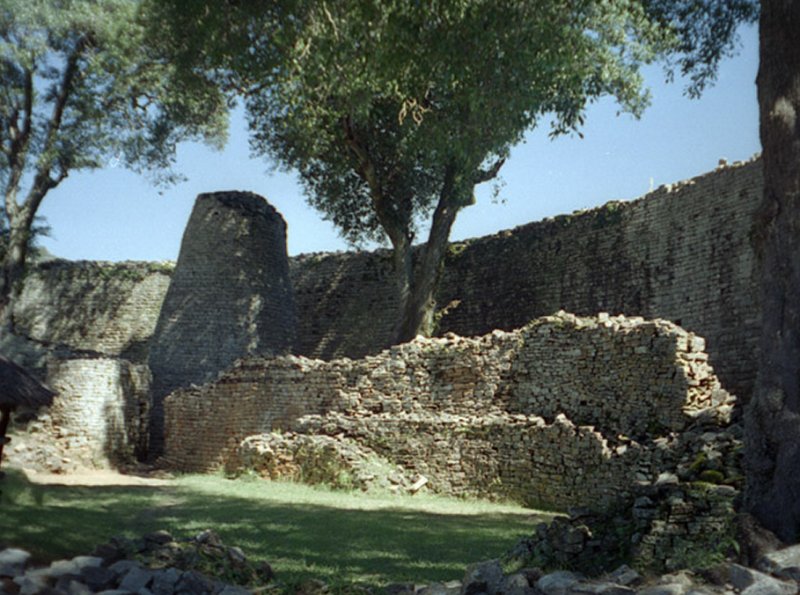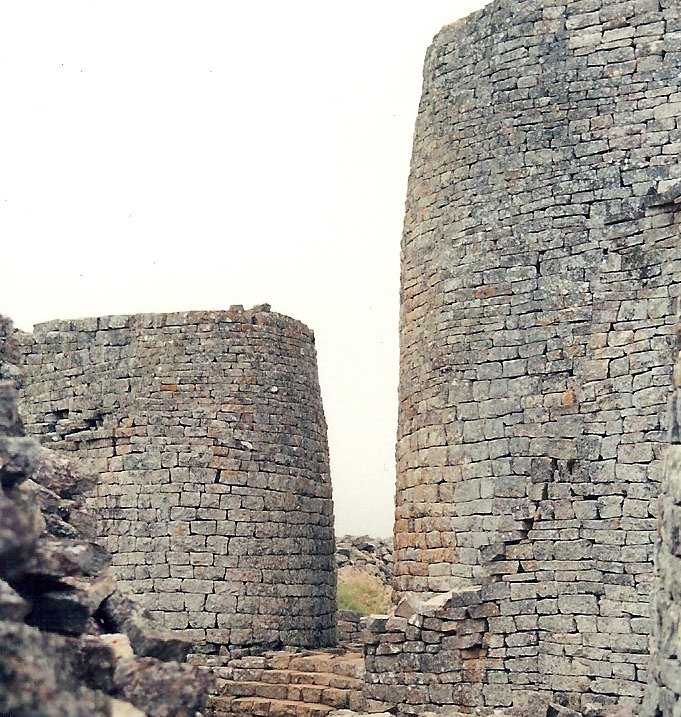Great Ruins of Zimbabwe: Unsolved Secrets Of Bizarre Buildings Without Windows And Doors
A. Sutherland - AncientPages.com - The ruins extending over approximately 385,000 square miles are located in Zimbabwe, on the high plateau of southern Africa.
The ruins contain the remains of about five hundred perplexing structures. Most of them are of conical shape, but it is not their shape that makes them so bizarre.
Inside of the Great Enclosure which is part of Great Zimbabwe ruins. Image credit: Jan Derk - Public domain
The lack of doors and windows and other openings made them useless for humans. The conical towers are thirty-three feet thick, and some elliptical walls are three stories tall.
"A square fortress, masonry within and without, built of stones of marvelous size, and there appears to be no mortar joining them," wrote Joao de Barros, of the first great Portuguese historians from the sixteenth century. He also mentioned the locals - illiterate people in the area - who referred to the ruins as Zimbabwe.
No one knew when and who built them, but these people were convinced that the structures were the devil's work. These strange buildings were constructed of rock, split into separate blocks, and put together without using mortar.
In 1868, the German traveler and explorer Adam Renders got lost in a deep South African jungle and accidentally came across the remarkable ruins near Lake Victoria.
Towers of Great Zimbabwe showing unmortared, dressed masonry. Taken c.1996 on film. Image credit: JackyR - CC BY-SA 3.0
Trying to get out of there, he was moving along the walls for a while, having the impression of going in circles. At that time, he did not know that he had found the Great Ruins of Zimbabwe.
Three years later, Karl Mauch (1837 - 1875), a German explorer, adventurer, and one of the first white men to find gold in the region, decided to research ruins that could belong to a legendary land, Ophir, famous for its gold mines and governed by one of the vassals of the Queen of Sheba. Any convincing proof of his assumption has never been found.
Adam Renders, who came upon the site, had perhaps no theories on its origin. But he was thinking about these curious ruins often and anxiously. He stayed for the rest of his life there and died in Zimbabwe.
Who were the unknown builders of these structures? What was the original purpose of these enigmatic buildings?
Among many theories, one suggested that the builders came from North Africa. Jewels, pearls, bracelets from Arabia, artwork from India, and at least one thousand years old Chinese porcelain were found, but no inscriptions could shed some light on the great mystery of the ruins.
"No mortar was employed, but the stone was dressed and squared by the hammer. Amongst the ruins numbers of relics have been discovered, including statuettes of Astarte or Venus in hawk form; Phallic symbols of various dimensions; bowls, trinkets, etc..." German ethnologist and archaeologist, Leo Frobenius said about the greatness of ruins.
Curved passageways circling the Great Enclosure Great Zimbabwe. Image credit: amanderson2 - CC BY 2.0
Did a lost race construct Zimbabwe? Had the ruins an astronomical purpose? Did a prehistoric race like the builders of Stonehenge create the conical towers? These structures could not have been intended to serve humans without doors, windows, or other openings.
On the citadel, some soapstone birds (eagles) have been found, placed on heavy five-foot-high stone pedestals similar to the Egyptian statues of falcon-headed Horus piloting his flying vehicle. What did the soapstone eagles from Great Zimbabwe Ruins symbolize?
Skillfully put together, the walls and towers of the Great Zimbabwe are evidence of power, knowledge, and a well-organized settlement. They are impressive monuments to their creators.
The puzzling origin of Zimbabwe's bizarre buildings remains a mystery.
Written by – A. Sutherland AncientPages.com Staff Writer
Updated on January 24, 2023
Copyright © AncientPages.com All rights reserved. This material may not be published, broadcast, rewritten or redistributed in whole or part without the express written permission of AncientPages.com
More From Ancient Pages
-
 Impressive Textile Reconstruction Shows What Viking Age People Dressed Like
Featured Stories | Sep 26, 2023
Impressive Textile Reconstruction Shows What Viking Age People Dressed Like
Featured Stories | Sep 26, 2023 -
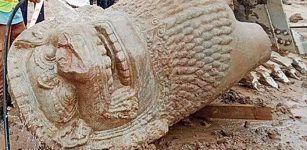 Two Pieces Of A Six-Foot-Tall Lion Statue Accidentally Found In Phnom Penh, Cambodia
Archaeology | Sep 12, 2020
Two Pieces Of A Six-Foot-Tall Lion Statue Accidentally Found In Phnom Penh, Cambodia
Archaeology | Sep 12, 2020 -
 Wreckage From Famous Warships Explored In 3D On Anniversary Of Sinking
Archaeology | Nov 22, 2022
Wreckage From Famous Warships Explored In 3D On Anniversary Of Sinking
Archaeology | Nov 22, 2022 -
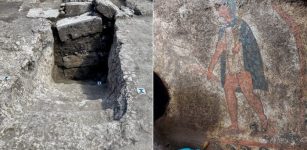 Extraordinary Painted Tomb Belonging To A Mercenary Warrior Found At Pontecagnano Necropolis
Archaeology | Oct 28, 2023
Extraordinary Painted Tomb Belonging To A Mercenary Warrior Found At Pontecagnano Necropolis
Archaeology | Oct 28, 2023 -
 Silla: The Most Successful Of Three Korean Kingdoms
Featured Stories | Aug 22, 2023
Silla: The Most Successful Of Three Korean Kingdoms
Featured Stories | Aug 22, 2023 -
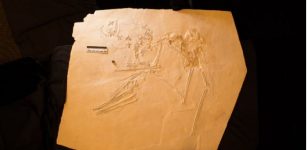 New Fossil Of 145-Million-Year-Old Pterosaur Nicknamed Elvis
Fossils | Jul 14, 2023
New Fossil Of 145-Million-Year-Old Pterosaur Nicknamed Elvis
Fossils | Jul 14, 2023 -
 Trees Are Deeply Rooted In Beliefs And Cultural Traditions Of Ancient People Around The World
Featured Stories | Feb 18, 2018
Trees Are Deeply Rooted In Beliefs And Cultural Traditions Of Ancient People Around The World
Featured Stories | Feb 18, 2018 -
 Large Earthwork At Wichita Site In Kansas – Is It Long-Lost Native American City Of Etzanoa?
Archaeology | Sep 4, 2020
Large Earthwork At Wichita Site In Kansas – Is It Long-Lost Native American City Of Etzanoa?
Archaeology | Sep 4, 2020 -
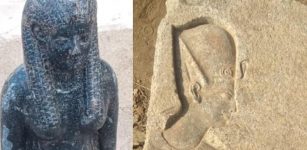 Artifacts Unearthed In Mit-Rahina, South Of Giza, Egypt
Archaeology | Jul 29, 2020
Artifacts Unearthed In Mit-Rahina, South Of Giza, Egypt
Archaeology | Jul 29, 2020 -
 Was Tintagel Castle A Fortress Used By Iconic Hero King Arthur?
Ancient Mysteries | Mar 12, 2016
Was Tintagel Castle A Fortress Used By Iconic Hero King Arthur?
Ancient Mysteries | Mar 12, 2016 -
 The Legend Of Little Deer—Interesting Cherokee Tale Of How Disease And Medicine Began, And Why The Native Americans Respect All Life
Featured Stories | May 10, 2017
The Legend Of Little Deer—Interesting Cherokee Tale Of How Disease And Medicine Began, And Why The Native Americans Respect All Life
Featured Stories | May 10, 2017 -
 Ancient Genomes Suggest Farming In Africa Was Ignited By Oversea-Migrants From Iberia 7,400 Years Ago
Archaeology | Jun 7, 2023
Ancient Genomes Suggest Farming In Africa Was Ignited By Oversea-Migrants From Iberia 7,400 Years Ago
Archaeology | Jun 7, 2023 -
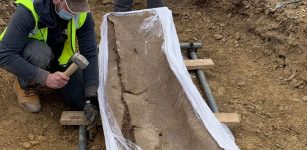 Once-In-A-Lifetime Find – Ancient Roman and Saxon Cemetery Unearthed In Leeds
Archaeology | Mar 30, 2023
Once-In-A-Lifetime Find – Ancient Roman and Saxon Cemetery Unearthed In Leeds
Archaeology | Mar 30, 2023 -
 Code Of Chivalry: ‘Knightly’ Behavior, Courageous Medieval Knights, Warriors And Superior Men
Featured Stories | Jun 5, 2016
Code Of Chivalry: ‘Knightly’ Behavior, Courageous Medieval Knights, Warriors And Superior Men
Featured Stories | Jun 5, 2016 -
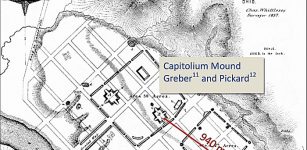 Archaeologists Refute Claims That A Comet Destroyed Hopewell Culture
Archaeology | Aug 11, 2023
Archaeologists Refute Claims That A Comet Destroyed Hopewell Culture
Archaeology | Aug 11, 2023 -
 Little People: Ancient Race That Pre-Dates Native Americans, Celts, And Other Settlers Worldwide
Featured Stories | Aug 29, 2024
Little People: Ancient Race That Pre-Dates Native Americans, Celts, And Other Settlers Worldwide
Featured Stories | Aug 29, 2024 -
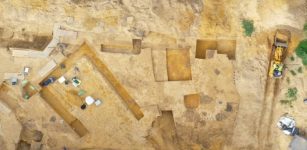 Unusual Mini Temples Discovered In Ancient Roman Camp In Haltern, Germany
Archaeology | Nov 16, 2023
Unusual Mini Temples Discovered In Ancient Roman Camp In Haltern, Germany
Archaeology | Nov 16, 2023 -
 Mama Quilla – Incan Moon Goddess Of Marriage And Fertility Assisted By High Priestesses Of Qoricancha
Featured Stories | Jun 15, 2020
Mama Quilla – Incan Moon Goddess Of Marriage And Fertility Assisted By High Priestesses Of Qoricancha
Featured Stories | Jun 15, 2020 -
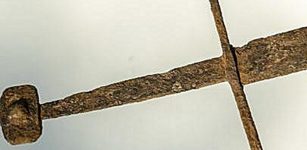 Medieval Well-Preserved Sword Discovered In A Peat Bog In Poland
Archaeology | Jun 21, 2017
Medieval Well-Preserved Sword Discovered In A Peat Bog In Poland
Archaeology | Jun 21, 2017 -
 Neanderthals Vanishing When Homo Sapiens Emerged In Europe Was Coincidental – Are Herbivores The Answer?
Evolution | Sep 29, 2023
Neanderthals Vanishing When Homo Sapiens Emerged In Europe Was Coincidental – Are Herbivores The Answer?
Evolution | Sep 29, 2023

